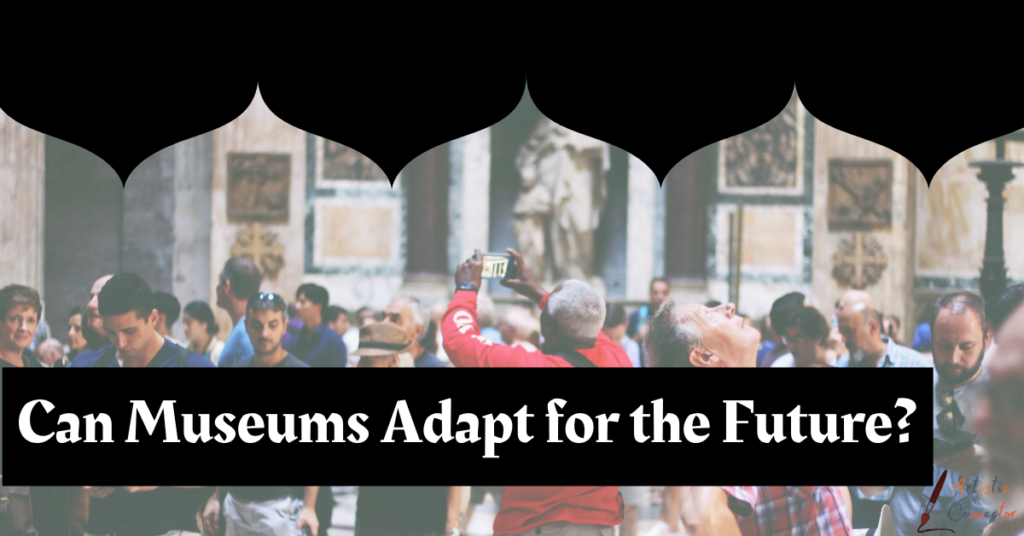American museums have needed to adapt since March 2020, as has everyone. We have discussed how museums are faring during Covid and many are not doing well. We have talked about the furloughed and laid-off staff, the closures, the delayed or canceled exhibitions, and the heaps of dollars in revenue lost. But there is another important loss: credibility. Museums have been arguing that they are essential to society and as cities and states came out of lockdown and museums were last to be reopened, “they couldn’t make the case that they were as essential to society as their advocacy had claimed them to be. 1 ” Museums are desperate to make a change.
History of Change
Change has been a long time coming for museums, however. We’ve seen how there has been a call to engage younger people, people from a variety of communities, and people of color. There has been a shift in exhibitions, which we’ve seen in Boston with the recent exhibits on gender-bending fashion, female artists, and graffiti artists, but this has been happening all over the world; “historically, museums… have upheld white patriarchal narratives, but at long last, more and more institutions are starting to show and collect more women and BIPOC artists. 2 ” Museums have understood that in order to engage with other audiences, they need to provide different content than what museums had traditionally shown. Museum education has taken the forefront in many museums to make art more accessible to everyone, regardless of background and education level. So, “the closures underscored the urgency of establishing a new connection with the audience, continuing a movement—begun back in the 1970s—to turn the museum from an exclusive intellectual enclave into a more open institution that seeks a reciprocal relationship with its visitors. 3 “
Emphasis on Digital Connection
As museums closes, most tried to engage with audiences digitally. Collections, lectures, exhibit tours all went online. Museums had been trying to integrate technology before the pandemic as more of our everyday lives became digital; they were trying to keep up. The pandemic was just another reason to provide digital content. However, there must be an equilibrium; “there is a concern that over-emphasis on technology is displacing human interaction. The importance of welcoming, contemplative spaces must be balanced with the pull of iconic architecture and activity-focused programming. 4 ” And digital content must be used strategically; too many times we see technology thrown into exhibits with no real depth behind it, just so the museum can say they’re reaching young people through the use of technology. Covid forced many museums to create or improve their digital strategy (only 25% of museums had a digital strategy before Covid and many did not even have a website 5 ) and they will need to keep that momentum going in the years to come. Technology is only going to be more central to our lives and museums will need to incorporate it in a meaningful and deliberate way if they also want to be central to our lives.
Emphasis on Community
Another change that has been happening over decades is a shift from object collecting being the primary focus to embracing the visitor and local communities. We’ve talked about the Gardner Museum’s After Hours program and that is something that many museums around the world were starting to do before the pandemic. Offering programming at night when young people get off work, at discounted rates that they can afford, appeals to that demographic. Giving them something to do that they particularly enjoy is also important. This is a new area that many museums are navigating, and we’ve discussed how they’ve gotten it right and wrong in the past and where the opportunities are in the future. But aside from young people, there is an opportunity to take this model and apply it to a wider range of audiences. Community engagement is becoming increasingly important and “a move toward greater institutional partnerships for programming and promotion, paired with a shift toward community engagement, is also an opportunity for museums to expand their influence and relevance.” Another opportunity is bringing art to communities with pop up museums “or partnering with local organizations to promote open-access digital content hubs.” Community engagement will need be balanced with traditional museum visitation as technology will need to be balanced with analog, but there is a future in which museums are community hubs and spaces of learning, discussion, and contemplation and that is an exciting future in which museums remain relevant.
Shifting Away from Object Collecting
Related to community engagement, there will be less of a focus on objects. There are a couple of reasons for this. First, most major museums have huge basements with racks upon racks of artifacts and objects that are never or rarely displayed because the exhibit space does not have room for them. Benefactors donate beloved art and artifacts to museums and then they just collect dust in a basement. Secondly, provenance is a, rightly, much more rigorous field than it used to be. We are seeing a lot of discussion about the repatriation of works that were stolen during the war, or purchased from an occupying force, and even pieces that are not nearly as major as the Benin Bronzes or the Parthenon Marbles are being returned to or demanded by their countries of origin. Even the pieces that are sold legally are sometimes questionable. There are many sacred objects displayed as art in museums from a variety of spiritual traditions. Museums display human remains in their Egyptian collections. Objects that we haven’t questioned for centuries and are viewed as cornerstones of museum collections may soon be viewed with a different lens by future generations if not sooner. The third reason that collecting objects is losing central focus in museums is that museum education is rising. There is an increase in focus on educating the public on what the museum already has. Doing research and conveying that information to the general public is increasingly important. This has been seen for the last 20 years or so in most major museums. Labels in exhibits have become much more informative and contextual. The visitor does not need to have a background in art to visit a museum anymore. This is a deliberate shift, and it will keep moving in a more accessible direction and away from object collecting.
Instead of fighting these changes, museums should embrace them and shift their focus on becoming what people want them to be so that they remain relevant.
How do you think museums will change in the next 10 years or so? What changes do you want to see? How do you think Covid has impacted those changes? Let us know in the comments!
- “A New Kind of Museum Is Emerging—Here’s What the Future Holds,” The Art Newspaper – International art news and events, November 27, 2020, https://www.theartnewspaper.com/2020/11/27/a-new-kind-of-museum-is-emergingheres-what-the-future-holds.
- Andras Szanto, “What Is the Future of Museums? 7 Predictions From Max Hollein, Koyo Kouoh, Anne Pasternak, and Other Top Curators and Directors,” Artnet News, January 1, 2021, https://news.artnet.com/art-world/future-of-museums-andras-szanto-1934142.
- “What Is the Future of the Museum?,” Gensler, accessed December 17, 2021, https://www.gensler.com/gri/museum-futures.
- “What Is the Future of Museums?,” Econsult Solutions, Inc. (blog), February 12, 2021, https://econsultsolutions.com/future-of-museums/.

